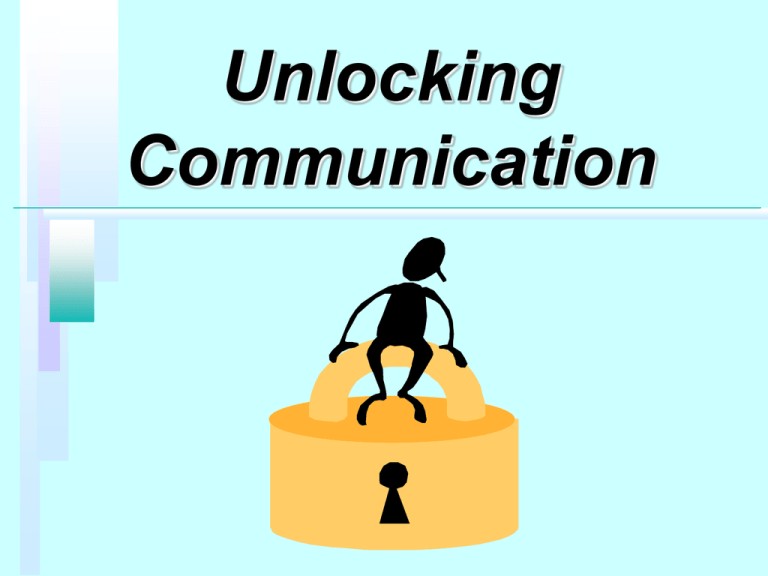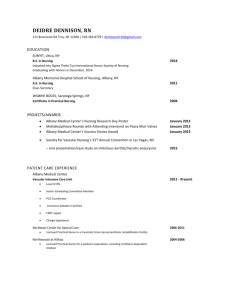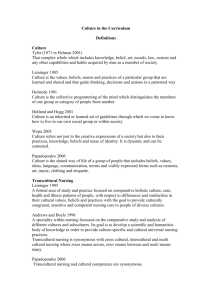Unlocking Communication
advertisement

Unlocking Communication You have the key: If the listener understands something different from what is meant, communication has not taken place- miscommunication has. Effective communication means what is understood matches what was intended. Communication with nurses is valued by older adults because… they appreciate nurses’… • knowledge • understanding approach • caring attitudes • kindness • sociability • intuition Ford, P., & Heath, H. (Eds.). (1996). Older people and nursing: Issues of living in a care home. London: Butterworth-Heinemann. Communication can be blocked by… physical impairments learning abilities cultural & ethnic differences emotional stresses age sex lack of mutual trust attitudes language distractions, noise failure to listen language barriers Effective Communication involves… active listening self-disclosure self-awareness awareness of others reciprocal disclosure meaningful relationship satisfaction that you have been heard Active Listening Techniques Open-ended Questions – can’t be answered with yes or no – begin with what, how, where, when – avoid why: makes one feel defensive Example: • Where were you when you fell? • What happened? Active Listening Techniques Expanders – encourage one to continue talking – nod head, eye contact, “I see”, “That’s interesting”, “Uh-huh” Active Listening Techniques Restatement Example: • Let me see if I heard you correctly: You fell in the kitchen, near the dog’s water which had spilled? Active Listening Techniques Reflection Example: “You seem angry about that.” “That sort of thing frustrates you.” Active Listening Techniques Silence Communication and Hearing Impairment Face client and establish eye contact Speak slowly and clearly Eliminate background noise Check and maintain hearing aids Supplement oral with written Clear obstruction from ear canal Check understanding with rephrasing Communication and Vision Impairment Ensure adequate lighting, free of glare Have assistive devices available and in use Written communication: black print on white or yellow paper, font size at least 14 Speak as you approach, touch hand or forearm Sit at eye level Communication and Culture: Time A central difference between cultures is the perception and use of time. In Western cultures, time may be seen as • Quantitative (“time is money”) • Linear In some Eastern cultures, time is seen as • Fluid, without boundaries • Circular (“we will get there eventually”) Luckmann, J. (1999). Transcultural communication in nursing. Albany: Delmar. Communication and Culture: Personal Space Personal space refers to the amount of space between individuals. It varies, depending on our culture and our relationships. For example: • In France, Latin America, and Africa, – closeness is preferred and distance is viewed as aloofness, dislike, or unwillingness to talk. • In the US, – distance between individuals is usually greater in a social context. As the relationship develops, people move closer together. Luckmann, J. (1999). Transcultural communication in nursing. Albany: Delmar. Communication and Culture: Eye Contact Old proverb: “The eyes are the windows of the soul.” In the US, • lack of eye contact is interpreted as the individual trying to hide something or avoiding the issue. In some other cultures, • prolonged eye contact is rude and an invasion of privacy. It may be seen as aggressive and hostile. Luckmann, J. (1999). Transcultural communication in nursing. Albany: Delmar. Communication and Culture: Silence Silence in a conversation can have several interpretations, depending on the cultural group: • • • • A space that needs to be filled Agreement between those talking Opportunity for everyone to speak A sign of respect and understanding • Time to reflect Luckmann, J. (1999). Transcultural communication in nursing. Albany: Delmar. Communication and Culture: The Nurse’s Role It is always important to recognize each person’s individuality, regardless of his or her culture. Understanding cultural differences… • facilitates the establishment of rapport with clients, families and communities. • assists in problem-solving clinical issues with positive outcomes for all involved. Luckmann, J. (1999). Transcultural communication in nursing. Albany: Delmar. Other Communication Approaches Reminiscence and life review Reality orientation Validation Relaxation Expressive writing Music Humor Touch – massage – Reiki Communication Tips Establish a relationship Focus on abilities Assess and reassess Keep client informed Eliminate distractions Be aware of roadblocks Use eye contact, listening skills and gestures Observe non-verbal cues Use adaptive devices Let person know when you don’t understand Client Teaching: Get and Keep Attention Make your point right from the start Vary your tone of voice Use assorted teaching methods Make the abstract concrete Client Teaching: Stick to the Basics Less is more Be specific about what you want the client to know Use simple everyday language Allow older adults more time for information processing Example: The 6 “P’s” of Insulin Injections Prepare (gather supplies, draw-up insulin) Pinch (pinch skin on stomach, thigh. Rotate) Poke (quickly poke skin, dart) Push-in (push plunger in) Pull-out (pull out syringe, do not rub skin) Put-away (put syringe in safety container) Copyright 1995 by C. R. Van Son Client Teaching: Make the Most of Your Time Incorporate teaching into client care activities Involve family members and caregivers Supplement your teaching with written materials if appropriate Client Teaching: Reinforcement is the Key Be a role model Reward, reward, reward Review material over several periods of time Client Teaching: Test Understanding Ask client to restate and returndemonstrate what you taught him or her. Have client (family member) keep a diary or record of behaviors. Review the written materials with the client, if appropriate. Overcome Barriers to Learning Physical barriers Emotional barriers Language and culture Literacy Simplify Writing Write short sentences Use easy to understand words Define clinical terms Use action words Number the steps Use pictures and diagrams Have large type Make lots of white space Teaching Tips Keep it simple Ask how client likes to learn Take time to get to know client Ask client if he or she has questions Don’t wait until the last minute Follow up Communication: A Team Effort Utilize other members of interdisciplinary team and make appropriate referrals Facilitate interagency exchange of information and support Acknowledge information from family members and caregivers Unlocking Communication was prepared by Catherine Van Son, Ph.D., R.N. for the Older Adult Focus Project, OHSU School of Nursing






